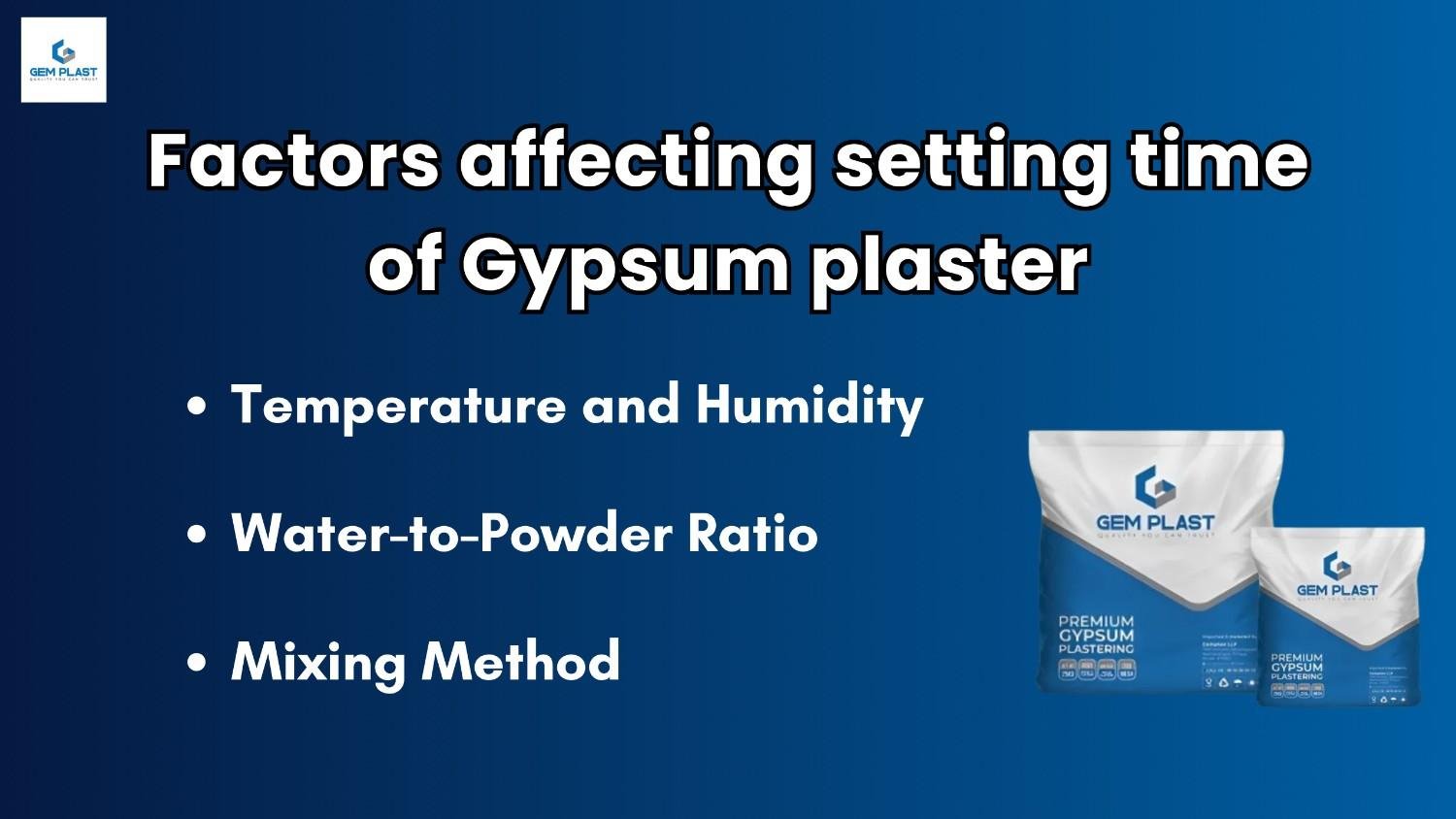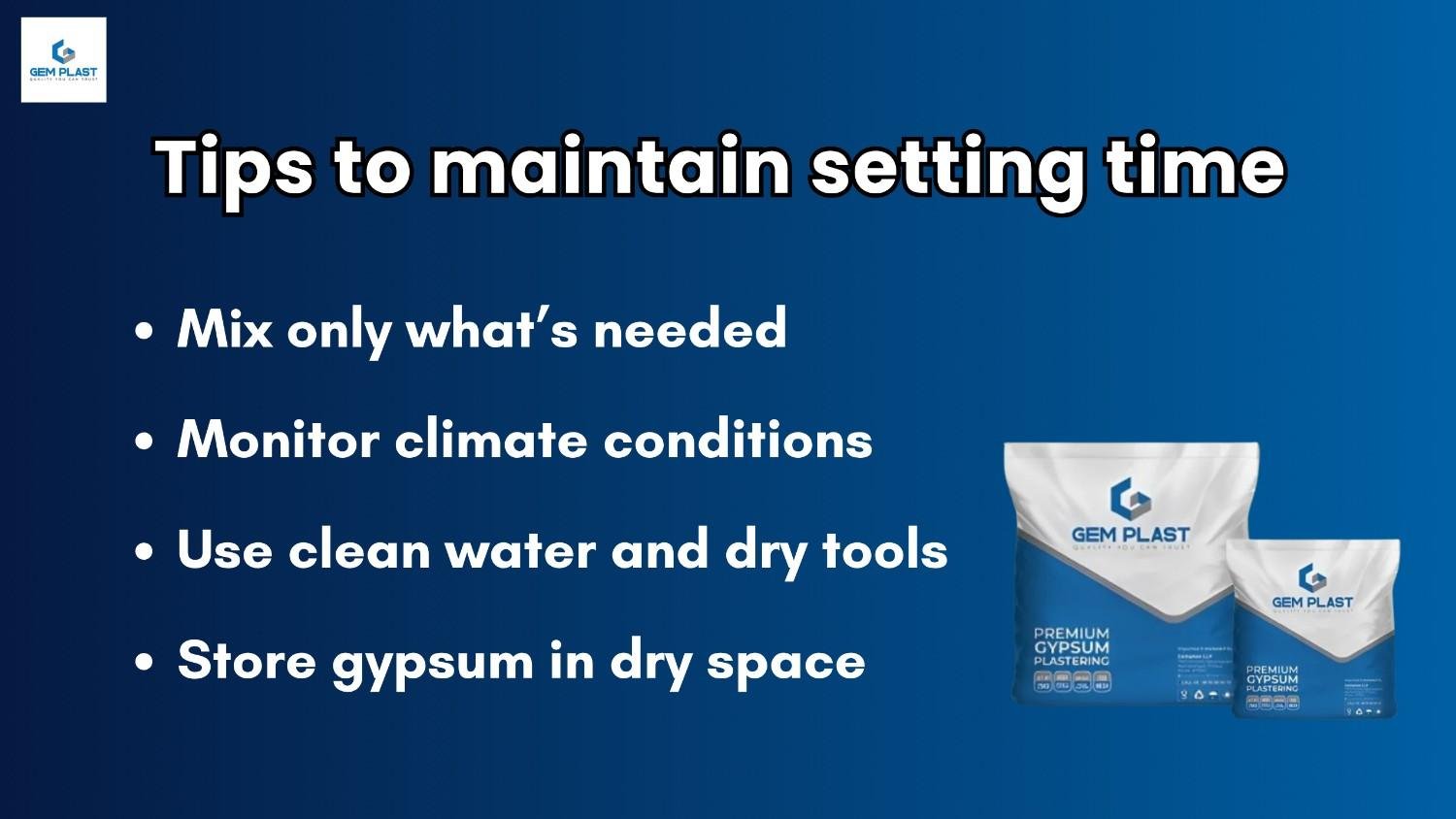Setting Time of Gypsum Plaster - A Complete Practical Guide

Gypsum plaster is a popular building material used in modern Indian construction. One of the most important things to know when working with gypsum plaster is its setting time. The setting time of gypsum plaster refers to how long it takes for the plaster to harden after mixing with water. The setting time of gypsum plaster can be divided into two phases. The initial setting time of gypsum plaster is 15 to 20 minutes. The final setting time of gypsum plaster is 22 to 30 days. If the weather is good, the final setting occurs in 5 to 7 days.
When it comes to interior finishing, timing is everything, especially with gypsum plaster. The setting time of gypsum plaster directly affects the quality of gypsum plastering work. If it sets too quickly, there’s no room to correct surface imperfections. If it sets too slowly, it delays the next stages of construction and increases labour costs. With over 22+ years of experience working on gypsum plastering projects inside and outside Kerala, we know how the climate plays a big role. Kerala’s high humidity can sometimes extend the setting time if not properly managed, which affects drying and finishing schedules. The main characteristics of gypsum plaster include quick setting time, smooth finish, excellent fire resistance, and ease of application.
What is the Setting Time of Gypsum Plaster
1. Initial setting time of gypsum plaster
The initial setting time of gypsum plaster is when the plaster starts to harden after it is mixed with water. It usually takes around 15 to 20 minutes. During this period, the plaster remains in working condition and can be spread smoothly on walls or ceilings. During this period, the plaster is soft and easy to apply. This is the most important stage for workers because once the plaster starts setting, it becomes difficult to spread or smooth out. So, all shaping and surface finishing should be done before the initial setting time ends. Understanding the setting time of gypsum plaster helps masons plan their work properly and avoid wastage or uneven surfaces.
2. Final Setting Time of gypsum plaster
This refers to the time by which the plaster becomes completely firm and starts gaining strength. For gypsum plaster, the final setting time is 22 to 30 days to become cured and strong. After this, the surface should not be touched or reworked. If the weather is warm and dry, the plaster can fully set and dry in just 5 to 7 days. Good airflow and moderate temperature help speed up the drying process. This final setting is important for painting or applying any finish coat, as it ensures the surface is strong and crack-free.
Why Setting Time of gypsum plaster Matters in Construction
1. Ensures a smooth and quality surface
The right setting time of gypsum plaster allows workers enough time to apply and level the surface properly before it begins to harden. It improves the surface quality, and the wall becomes smooth.
2. Saves time and cost
Proper control over the setting time of gypsum plaster helps avoid project delays and additional expenses due to corrections or repairs.
3. Better scheduling for workers
When the setting time of gypsum plaster is known and steady, it becomes easier to plan the next steps in construction. For example, if the plaster needs a few hours to set, workers can arrange other tasks like painting, electrical fittings, or flooring without delays.
4. Increases lifespan and better control for builders
A properly set plaster bond is stronger and lasts longer, which means fewer maintenance issues over time. Understanding the gypsum plaster thickness, hot weather, and mixing affect the setting time of gypsum plaster helps professionals plan better and maintain consistent quality.
Factors that Affect The Setting Time of Gypsum Plaster

When comparing gypsum plaster vs cement plaster, gypsum plaster has a much faster setting time, making it ideal for projects that need quicker completion. The setting time of gypsum plaster can change depending on several factors, especially in a region like Kerala and south India, where the climate plays a big role. Here are some key things that influence how fast or slow gypsum plaster sets:
1. Temperature & Humidity
In warm and humid weather, plaster can take longer to set. High humidity slows down the drying process, while very hot conditions can cause it to set too quickly. That’s why it’s important to apply plaster during moderate weather or ensure proper ventilation at the site.
2. Water-to-Powder Ratio
The amount of water used while mixing the plaster affects the setting time. Too much water can delay setting and reduce strength, while too little water may cause cracks. A proper balance is key for achieving the right setting time.
3. Mixing Method
The way gypsum plaster is mixed plays a big role in how fast it sets. If the plaster isn’t mixed properly, with uneven lumps or dry patches, it can delay the setting time of gypsum plaster or cause weak bonding. For best results, it’s important to use clean water, add plaster gradually, and stir continuously to get a smooth mix. A consistent mixture ensures a uniform setting across the surface, which helps avoid cracks and gives a better finish.
Real-Time Tips for Contractors & Site Workers

1. Mix only what’s needed
When working with gypsum plaster, always mix only the amount you need for the job. Mixing in small batches helps control the setting time of gypsum plaster and avoids wastage. If you mix too much at once, the plaster may begin to harden before you can apply it, leading to a poor finish and material loss.
2. Monitor climate conditions
The weather plays a big role in how fast or slow the plaster sets. In a hot or humid place like Kerala, the setting time of gypsum plaster can change based on temperature and moisture in the air. Contractors should always check the climate and plan their work accordingly to ensure smooth application and a good surface finish.
3. Use clean water and dry tools
For best results, always use clean water and make sure your tools are dry before mixing and applying gypsum plaster. Dirty or wet tools can change the setting time of gypsum plaster and may weaken its strength. Clean tools also give a smoother finish and make your work more professional.
4. Store gypsum in dry space
Gypsum plaster should always be stored in a dry, covered place. If the material gets exposed to moisture or dampness, it can start reacting early or become unusable. This not only affects the quality but also changes the setting time of gypsum plaster, which may delay work on site and lead to poor results.
Conclusion
Gypsum plaster benefits include faster application, a smooth finish, reduced shrinkage cracks, and better thermal insulation for walls and ceilings. If the plaster sets too fast, there won’t be enough time to level and finish the surface properly. If it sets too slowly, it may crack or lose strength. That’s why knowing the right timing helps workers apply it neatly and get a better final look.
Normal initial setting time is 15 – 20 minutes, and final setting time is 22 – 30 days to become completely cured. If the climatic conditions are good, the final setting will occur in 5 – 7 days. Gypsum plastering in Kerala is becoming popular for its quick setting time, which helps speed up construction without compromising on quality.
FAQs
1. Does the climate affect the setting time?
Ans. Yes, it does. The hot and humid weather can change the setting time of gypsum plaster. High humidity may slow down drying, while heat can speed up setting. That’s why timing and proper storage are very important for good results in local projects.
2. Can I reuse leftover mixed plaster?
Ans. No. Once mixed, gypsum plaster starts its setting process. If the setting time of gypsum plaster has already begun, reusing it will weaken the bond. Always mix only what you can apply in 10–15 minutes to avoid waste.
3. What if the plaster hardens too fast?
Ans. If your plaster is hardening too quickly, it means the setting time of gypsum plaster is shorter than needed. This could be because of hot weather, poor storage, or overmixing. In such cases, don’t try to add more water after it starts setting, as that can weaken the plaster. It’s better to mix smaller batches and apply quickly.
